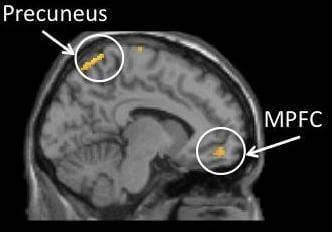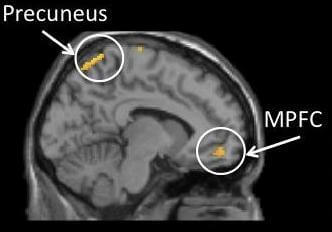MRI Scans Are Better At Predicting Your Behavior Than You Are

Share
Researchers at UCLA have discovered that MRI scans of your brain allow them to predict your future behavior better than you can. As discussed in the Journal of Neuroscience, people are generally about 50% accurate in predicting how they would adopt a new habit (using sunscreen in the experiment). By studying bloodflow to the precuneus and medial prefrontal cortex of the brain (both associated with self-reflection) scientists could accurately predict behaviour about 75% of the time. While very limited in its scope and sampling size, UCLA's new insight into understanding how people will behave could have remarkable effects on everything from advertising to education. This is just one of several ways in which brain scans are poised to change our future.
We've seen a developing trend towards using MRI imaging to determine 'what's really going on' in your mind. There have been ongoing efforts to use fMRI scans as lie-detectors for civil and criminal cases in the US, with little success so far. Researchers are attempting to be able to see 'what the brain sees' by directly reading activity in the visual cortex. Others are seeing how the technology may fit in with advanced security checkpoints. The UCLA research is unique however, because it does more than suppose a better understanding of what you're thinking now, it suggests it might be able to predict what you are going to do.
The implications are huge. We could scan children as they are being taught and get a better understanding of what, if anything, they will retain later. The UCLA staff (in a University news article) reported that the technology may lead to 'neural focus groups' for marketing research. If advanced enough, the technology could even be used (perhaps erroneously) to help predict if criminals are likely to change their ways upon release. The concept of a machine being able to better understand your future behavior than you yourself could predict is a powerful and scary idea. The current reality, seen in the UCLA research, is actually rather limited however.
In the study, volunteers in an MRI machine were shown public service announcements about the importance of wearing sunscreen. Their brains were monitored, especially in two regions of interest: the precuneus and medial prefrontal cortex. Those patients then predicted how often they would wear sunscreen in the next week. They were given sunscreen to make sure they would have access to it. Researchers followed up with a survey to track their actual use over the week. Only about half of volunteers accurately predicted their own future behavior. Meanwhile, scientists could use scans of the precuneus and medial prefrontal cortex of the brain to predict volunteer behaviour about three-fourths of the time.
How was this prediction made? The sample size of the study was small (10 men, 10 women) because of the costs and time associated with MRI technology. Rather than study the results of each volunteer and then predict an outcome, researchers waited until the results were in. They then randomly selected 10 people and used their scans and results to build a computer model for prediction which they then used on the remaining 10 people. Of course, they didn't want to be limited to just one random selection, so they repeated this process for every possible combination of 10 models and 10 test subjects. That's 184,756 repetitions if anyone's counting. Taken as a whole, the MRI-based models ended up around 75% accurate in predicting the results of the other group from their scans.
Be Part of the Future
Sign up to receive top stories about groundbreaking technologies and visionary thinkers from SingularityHub.


This is actually a fairly reliable and interesting approach to the problem, but we shouldn't be blind to its limitations. 20 people is a tiny sample set, no matter what statistical expertise you apply to it. The study also relied on volunteers to self-report their own sunscreen use during the test week. This introduces bias into the results, but presumably in favor of raising a volunteers own self-prediction accuracy (one assumes people will tend to lie to make themselves have been right in the past). The researchers acknowledge these limitations in their paper, and hope to pursue a larger testing group with better controls in the future.
The bigger limitation here, however, is that this early study into the phenomenon does not truly simulate a real-world experience. Being inside a two-ton machine while being shown slides on sunscreen isn't the way that most of us are exposed to influencing media. It also doesn't take into account long standing attitudes and histories with the product or idea being presented (sunscreen use). Even if we eventually get very good at building MRI models to predict people's response to stimuli in a lab setting, that doesn't necessarily mean we'll be able to predict things in the more chaotic and dynamic outside world.
That being said, I'm still rather excited by this work. As mysterious as we may find our mind and consciousness, experiments like this one demonstrate that our brain is a fairly understandable organ. When regions of the brain are used heavily, you can reasonably predict that their specialties are affecting what we're thinking. For example, in the UCLA study researchers noticed increase activity in the parts of the brain that handled self-reflection (like the precuneus and medial prefrontal cortex) predicted a change in behavior (using more sunscreen). The research team also found correlations between the regions of the brain that handle perspective of others, memory encoding, attention, visual imagery, motor execution and imitation, and affective experience with increased behavior change. Hinting that each of these is a factor in determining how and why we ultimately choose to do something new.
This is really fascinating stuff, and it shows that not only can we learn about the brain, but that we have a lot more to learn before we fully understand it. The predictive models at UCLA need years of more work before they are likely to find applications, but the potential that they could succeed is certainly there. Along with other uses for truth detection, image processing, and emotional state, the predictive models show that MRI may become one of the more versatile and powerful diagnostic tools of the future. Now if only someone could make it smaller and portable - the giant metal cocoon look is so last century.
[image credits: Falk et al, JoN 2010]
[source: *Falk et al, JoN 2010; UCLA News]
*Full PDF of the report is available via the Social Cognitive Neuroscience Lab at UCLA.
Related Articles

Study: AI Chatbots Choose Friends Just Like Humans Do

AI Companies Are Betting Billions on AI Scaling Laws. Will Their Wager Pay Off?

Are Animals and AI Conscious? Scientists Devise New Theories for How to Test This
What we’re reading

